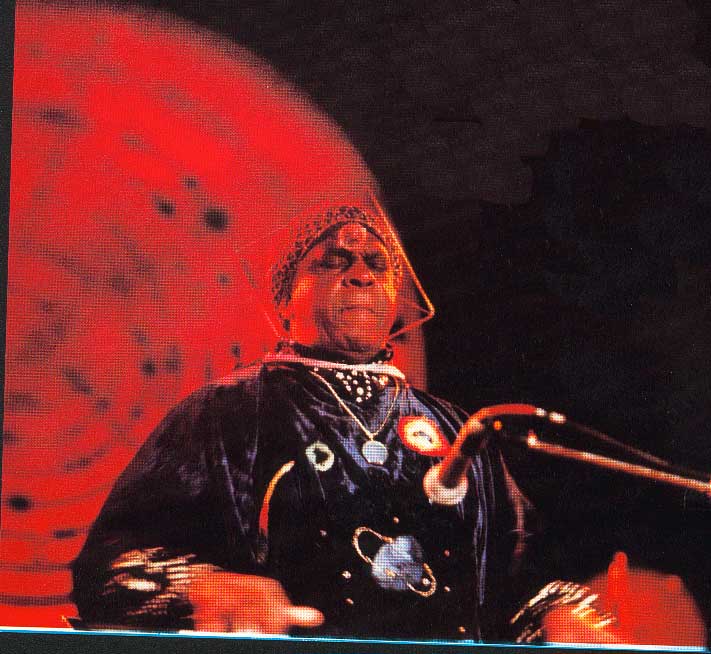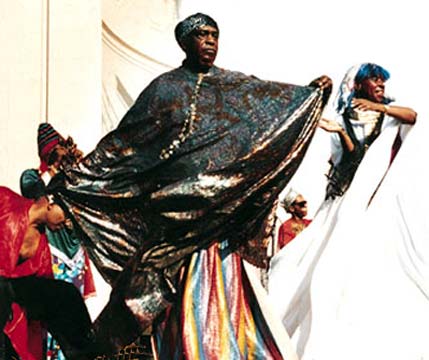SUN RA / “I’ll Wait For You”
I just realized that Grace Jones’ Nightclubbing (which I wrote about in this week’s ‘Classic’ post), Prince’s Dirty Mind (one of my all-time favorite albums which I wrote about back in October) and Sun Ra’s Strange Celestial Road (probably my favorite Sun Ra album) were all released in 1980 or 1981. The latter year also saw the release of Grandmaster Flash’s “Adventures On The Wheels Of Steel,” the first and (if you’re asking me) still best DJ mix ever recorded. I’m sitting here imagining that at one moment late in 1980, Grace Jones, Prince, Sun Ra’s Arkestra and Grandmaster Flash were all in recording studios at the same time, all laying down revolutionary sounds that would still sound as alive and full of positive vibes as they did back in 1980. Thinking about it now, I’m overwhelmed, frankly. Hell, with all of that sonic brilliance being born at the same moment, it’s a wonder time and space didn’t collapse. OK, I’m getting myself lost somewhere in Hyperboleville and I have a post to write. So let’s go.
 Strange Celestial Road is an album from Sun Ra’s brief late-Seventies/early-Eighties ‘funk’ period and also happens to be the first Sun Ra music I ever heard. (On purpose, at least. I’m sure Kalamu blessed us with some Arkestra music when I was still in diapers.) That album being my first was good because it hooked me on Sun Ra, encouraging me to keep checking out more of the man’s labyrinth-like catalog. But it was also bad because it gave me the wrong idea about Sun Ra and his music. First, two of the three songs have vocals. And not just any vocals, they have vocal hooks…you can actually (and easily) sing along if you want to. Second, all three songs have real, actual 4/4 grooves. If you’d cut your teeth on hip-hop, reggae and funk (like I had), Strange Celestial Road went down easy.
But don’t confuse this album for instrumental funk-lite as per Grover Washington Jr. or for the sometimes awkward-sounding attempts at funk made by more ‘serious’ jazz musicians. When it comes to funk, this is the real deal: wah-wah guitars, wall-to-wall multi-layered percussion, fat and nasty basslines, the works. Of course, Sun Ra being Sun Ra, it isn’t straight funk either. The lyrics talk about ‘traveling to endless heaven’ and places ‘where human eyes have never seen.’ The reed solos are as frequent and as involved as on any of Sun Ra’s more jazz-oriented albums. And the unifying sound is a piercing, high-pitched drone that comes and goes throughout all three pieces. But for all the weirdness, for all the off-the-wall lyrics and bizarre sound effects, the most notable thing about Strange Celestial Road is how relaxing the music is. Sun Ra’s brand of funk is strange but mellow, complex but soothing. All you have to do is lay back, tune in and let the Arkestra take you to the stars.
—Mtume ya Salaam
Note: Strange Celestial Road is billed as an album, but with a total running time of just over 25 minutes and a track listing of only three songs, it’s more accurately considered an EP. Given its brevity, it’s relatively expensive, but worth it. And if you’re thinking of going the iTunes route and buying each song for $0.99 each, guess again. Two of the three songs are ‘Album Only.’ Sorry.
Another 80s story
During the Eighties, yours truly was deep into music production: festivals, recordings, concerts, etc., plus a stint as executive director of the New Orleans Jazz & Heritage Foundation, the parent organization of the New Orleans Jazz & Heritage Festival, aka “Jazzfest.”
Inspired by Harold Battiste, I decided to document the New Orleans jazz scene of that period. This documentation process included a three-LP series on Rounder Records called The New New Orleans Music. One of the six groups recording for this particular project was composer and bass player Ramsey McLean and the Survivors, an aggregation that featured Charmaine Neville on vocals and Herlin Riley (later to be known as Wynton Marsalis’ main drummer) on percussion. Trivia note: the off-and-on, not quite permanent pianist for that group was a young Harry Connick, Jr., who happened to be out of town the day we were in the studio.
The selections from Ramsey and cohort were widely varied, ranging from a Dave Bartholomew number that is popularly remembered by old-timers in New Orleans as a commercial for a local beer to a serious music composition dedicated to Charles Mingus. But the number under consideration here is The Survivors’ version of Sun Ra’s “Rocket #9.”
I cite Ramsey’s “Rocket #9” specifically to second Mtume’s observation about Sun Ra’s space-funk. One listen and you know this is a jump-up number that nobody would mistake for “serious” avant garde music, which, as Mtume noted, is the bag most jazz heads place Sun Ra in.
Strange Celestial Road is an album from Sun Ra’s brief late-Seventies/early-Eighties ‘funk’ period and also happens to be the first Sun Ra music I ever heard. (On purpose, at least. I’m sure Kalamu blessed us with some Arkestra music when I was still in diapers.) That album being my first was good because it hooked me on Sun Ra, encouraging me to keep checking out more of the man’s labyrinth-like catalog. But it was also bad because it gave me the wrong idea about Sun Ra and his music. First, two of the three songs have vocals. And not just any vocals, they have vocal hooks…you can actually (and easily) sing along if you want to. Second, all three songs have real, actual 4/4 grooves. If you’d cut your teeth on hip-hop, reggae and funk (like I had), Strange Celestial Road went down easy.
But don’t confuse this album for instrumental funk-lite as per Grover Washington Jr. or for the sometimes awkward-sounding attempts at funk made by more ‘serious’ jazz musicians. When it comes to funk, this is the real deal: wah-wah guitars, wall-to-wall multi-layered percussion, fat and nasty basslines, the works. Of course, Sun Ra being Sun Ra, it isn’t straight funk either. The lyrics talk about ‘traveling to endless heaven’ and places ‘where human eyes have never seen.’ The reed solos are as frequent and as involved as on any of Sun Ra’s more jazz-oriented albums. And the unifying sound is a piercing, high-pitched drone that comes and goes throughout all three pieces. But for all the weirdness, for all the off-the-wall lyrics and bizarre sound effects, the most notable thing about Strange Celestial Road is how relaxing the music is. Sun Ra’s brand of funk is strange but mellow, complex but soothing. All you have to do is lay back, tune in and let the Arkestra take you to the stars.
—Mtume ya Salaam
Note: Strange Celestial Road is billed as an album, but with a total running time of just over 25 minutes and a track listing of only three songs, it’s more accurately considered an EP. Given its brevity, it’s relatively expensive, but worth it. And if you’re thinking of going the iTunes route and buying each song for $0.99 each, guess again. Two of the three songs are ‘Album Only.’ Sorry.
Another 80s story
During the Eighties, yours truly was deep into music production: festivals, recordings, concerts, etc., plus a stint as executive director of the New Orleans Jazz & Heritage Foundation, the parent organization of the New Orleans Jazz & Heritage Festival, aka “Jazzfest.”
Inspired by Harold Battiste, I decided to document the New Orleans jazz scene of that period. This documentation process included a three-LP series on Rounder Records called The New New Orleans Music. One of the six groups recording for this particular project was composer and bass player Ramsey McLean and the Survivors, an aggregation that featured Charmaine Neville on vocals and Herlin Riley (later to be known as Wynton Marsalis’ main drummer) on percussion. Trivia note: the off-and-on, not quite permanent pianist for that group was a young Harry Connick, Jr., who happened to be out of town the day we were in the studio.
The selections from Ramsey and cohort were widely varied, ranging from a Dave Bartholomew number that is popularly remembered by old-timers in New Orleans as a commercial for a local beer to a serious music composition dedicated to Charles Mingus. But the number under consideration here is The Survivors’ version of Sun Ra’s “Rocket #9.”
I cite Ramsey’s “Rocket #9” specifically to second Mtume’s observation about Sun Ra’s space-funk. One listen and you know this is a jump-up number that nobody would mistake for “serious” avant garde music, which, as Mtume noted, is the bag most jazz heads place Sun Ra in.
 Anyone who has seen the band in concert knows that there were no limits whatsoever on Sun Ra’s music. He had a light show. He had dancers. He had singers. He had a whole Arkestra of multi-colored-costumed, crazy-ass musicians. When Ra came to town, the circus had to shut down cause they couldn’t compete. Whether you understood Ra or were totally confused by his show, whether you dug him or were turned off by the insane intensity of his music, one thing is for sure: you were never bored.
Sun Ra’s stated purpose was to alter your consciousness. Ra wanted to expand the space inside your head. Ra wanted you to embrace outer space. Ra knew that to achieve his objections he had to offer a potent sonic tonic.
Ra was out there and inviting you to join him. To paraphrase a Sun Ra chant: when you find earth boring, the same-old, same-old, sign up for outer spaceways incorporated. All aboard.
—Kalamu ya Salaam
Anyone who has seen the band in concert knows that there were no limits whatsoever on Sun Ra’s music. He had a light show. He had dancers. He had singers. He had a whole Arkestra of multi-colored-costumed, crazy-ass musicians. When Ra came to town, the circus had to shut down cause they couldn’t compete. Whether you understood Ra or were totally confused by his show, whether you dug him or were turned off by the insane intensity of his music, one thing is for sure: you were never bored.
Sun Ra’s stated purpose was to alter your consciousness. Ra wanted to expand the space inside your head. Ra wanted you to embrace outer space. Ra knew that to achieve his objections he had to offer a potent sonic tonic.
Ra was out there and inviting you to join him. To paraphrase a Sun Ra chant: when you find earth boring, the same-old, same-old, sign up for outer spaceways incorporated. All aboard.
—Kalamu ya Salaam
This entry was posted on Sunday, January 14th, 2007 at 12:51 am and is filed under Classic. You can follow any responses to this entry through the RSS 2.0 feed. You can leave a response, or trackback from your own site.
Leave a Reply
| top |